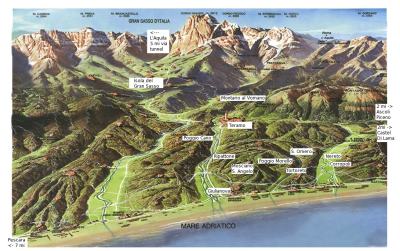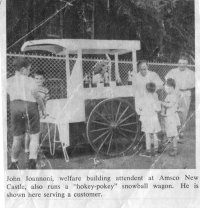
Click on map to see enlarged full map. Courtesy F. Ianni
* Arriving in Delaware, the Italian-American Experience.Priscilla M. Thompson, ed Barbara E Benson, The History Store and Italo-Americans United, P.O. Box 207, Wilmington, DE.
Italian-Americans in New Castle
Many nationalities came to New Castle in its first two centuries-- Swedish, Dutch, English, Scots, Irish ..., however not Italians.
In the 1870 census, although 207 of the 1915
people living in New Castle were listed as born in Ireland, there was not a single person listing Italy as their birthplace.
As Priscilla Thompson describes in detail* in 'Arriving in Delaware, The Italian-American Experience' Italians began to come to America from southern Italy in large numbers after 1880. Frequently men came over without their families and sent funds back home, or went back themselves after some years.
Wedding in 1926 of Mary Marcozzi & Francis Ianni, Rose Marcozzi & Pietro Pierantozzi. Courtesy F. Ianni

Among the earliest to come to New Castle were Carlo Marcozzi from Teramo province in Abruzzo in 1898, and a few years later Francesco and Nicola Ianni. Marcozzi went back to Italy in 1902, and returned a year later with his wife and brothers. Marcozzi (age 31) is listed in the 1910 federal census as being head of a house along with his wife Mary, children Rose, Mary and John and 7 boarders (all from Italy). Only Carlo is listed as speaking English. Carlo, and all the boarders work as 'track men' on a 'steam RR'.
Teramo province of Abruzzo with family origins by A. Alvini. Map courtesy tourism department of Teramo Province.
Map showing the origins in Abruzzo of New Castle families
Italian men came to America (according to Thompson) because of the push of economic hardship in Italy, and the pull of demand for labor in the U.S. Italy had recently been united and freed from foreign rulers so, there was not the political (or religious) persecutions that had driven others to immigrate here. As a result some men sent money home to family, others returned to Italy themselves, and many others, like Carlo Marcozzi brought their families here.
The federal census show the growth of the New Castle Italian-American community from 2 families in 1900 to about 40 people born in Italy or their children in 1910 to about 250 Italian-Americans in 1920. Most of the Italians born residents listed in the 1900 and 1910 census moved elsewhere. Only the Marcozzi and Lalli familes remained to form the nucleus of the current community. By 1920, many of the families had arrived whose descendents still live here.
Initially much of the work the men found was as laborers at a steel mill or on the railroad. The families lived nearby in Shawtown near the railroad and Deemer Steel or Dobbinsville (Dobbins, Gray and Clymer Streets). Shawtown was named for James G. Shaw who owned the factory that was the predecessor to Deemer steel, Dobbinsville was built by Richard J. Dobbins to house workers for the Tasker iron works which had closed around 1900. Dobbinsville was was quite diverse ethnically and included Austrians, Poles, Lithuanians, Russians and Swedes.
None of the wives listed in the census worked outside of the home. Household size averaged 6 in 1920. About 1/3 of the households had boarders (mostly Italian men). According to Thompson, taking in boarders was a common practice nationwide.
Others [names, dates?] have contributed descriptions of the clubs, organizations, businesses that members of the communities opened.
 Some customs brought over are now only memories. One shared by many is the
special celery grown by Carlo Marcozzi for the holidays.
Some customs brought over are now only memories. One shared by many is the
special celery grown by Carlo Marcozzi for the holidays.
 Another is the "hokey pokey man's"
push cart . John Ionannoni
recalls that each day after working a full day at AMSCO (the American Manganese steel plant), John's father
would wheel the push cart from 10th & Delaware through the streets of town to the end of Harmony and back.
Another is the "hokey pokey man's"
push cart . John Ionannoni
recalls that each day after working a full day at AMSCO (the American Manganese steel plant), John's father
would wheel the push cart from 10th & Delaware through the streets of town to the end of Harmony and back.
As Priscilla Thompson describes in detail* in 'Arriving in Delaware, The Italian-American Experience' Italians began to come to America from southern Italy in large numbers after 1880. Frequently men came over without their families and sent funds back home, or went back themselves after some years.
Wedding in 1926 of Mary Marcozzi & Francis Ianni, Rose Marcozzi & Pietro Pierantozzi. Courtesy F. Ianni

Among the earliest to come to New Castle were Carlo Marcozzi from Teramo province in Abruzzo in 1898, and a few years later Francesco and Nicola Ianni. Marcozzi went back to Italy in 1902, and returned a year later with his wife and brothers. Marcozzi (age 31) is listed in the 1910 federal census as being head of a house along with his wife Mary, children Rose, Mary and John and 7 boarders (all from Italy). Only Carlo is listed as speaking English. Carlo, and all the boarders work as 'track men' on a 'steam RR'.
Teramo province of Abruzzo with family origins by A. Alvini. Map courtesy tourism department of Teramo Province.

Map showing the origins in Abruzzo of New Castle families
Italian men came to America (according to Thompson) because of the push of economic hardship in Italy, and the pull of demand for labor in the U.S. Italy had recently been united and freed from foreign rulers so, there was not the political (or religious) persecutions that had driven others to immigrate here. As a result some men sent money home to family, others returned to Italy themselves, and many others, like Carlo Marcozzi brought their families here.
The federal census show the growth of the New Castle Italian-American community from 2 families in 1900 to about 40 people born in Italy or their children in 1910 to about 250 Italian-Americans in 1920. Most of the Italians born residents listed in the 1900 and 1910 census moved elsewhere. Only the Marcozzi and Lalli familes remained to form the nucleus of the current community. By 1920, many of the families had arrived whose descendents still live here.
Initially much of the work the men found was as laborers at a steel mill or on the railroad. The families lived nearby in Shawtown near the railroad and Deemer Steel or Dobbinsville (Dobbins, Gray and Clymer Streets). Shawtown was named for James G. Shaw who owned the factory that was the predecessor to Deemer steel, Dobbinsville was built by Richard J. Dobbins to house workers for the Tasker iron works which had closed around 1900. Dobbinsville was was quite diverse ethnically and included Austrians, Poles, Lithuanians, Russians and Swedes.
None of the wives listed in the census worked outside of the home. Household size averaged 6 in 1920. About 1/3 of the households had boarders (mostly Italian men). According to Thompson, taking in boarders was a common practice nationwide.
A History Of Italians in New Castle
by Alexander Alvini (1979)
Introduction
Food
Medicine
Education
Religion
Weddings
Columbus Day
For a closer understanding of life in the Italian American community, look at the
history of the New Castle Italian American Community by Alexander Alvini
In it he describes topics ranging from
food, food stores, local wine production and butchering, religion, celebrations, doctors,
midwife. by Alexander Alvini (1979)
Introduction
Food
Medicine
Education
Religion
Weddings
Columbus Day
Others [names, dates?] have contributed descriptions of the clubs, organizations, businesses that members of the communities opened.
 Some customs brought over are now only memories. One shared by many is the
special celery grown by Carlo Marcozzi for the holidays.
Some customs brought over are now only memories. One shared by many is the
special celery grown by Carlo Marcozzi for the holidays.
 Another is the "hokey pokey man's"
push cart . John Ionannoni
recalls that each day after working a full day at AMSCO (the American Manganese steel plant), John's father
would wheel the push cart from 10th & Delaware through the streets of town to the end of Harmony and back.
Another is the "hokey pokey man's"
push cart . John Ionannoni
recalls that each day after working a full day at AMSCO (the American Manganese steel plant), John's father
would wheel the push cart from 10th & Delaware through the streets of town to the end of Harmony and back.
* Arriving in Delaware, the Italian-American Experience.Priscilla M. Thompson, ed Barbara E Benson, The History Store and Italo-Americans United, P.O. Box 207, Wilmington, DE.
James L. Meek '08